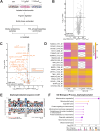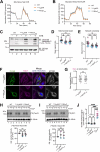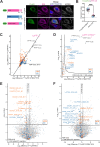Legionella effector LpPIP recruits protein phosphatase 1 to the mitochondria to induce dephosphorylation of outer membrane proteins
- PMID: 40700448
- PMCID: PMC12313075
- DOI: 10.1371/journal.pbio.3003261
Legionella effector LpPIP recruits protein phosphatase 1 to the mitochondria to induce dephosphorylation of outer membrane proteins
Abstract
Legionella pneumophila utilizes a type IVB secretion system (T4SS) to translocate over 300 effector proteins into host cells, hijacking cellular processes, including those within the mitochondrion. Currently, no Legionella effectors have been identified at the mitochondrial outer membrane, a critical interface between the organelle and the rest of the cell. We screened the Legionella effector repertoire for features of mitochondrial tail-anchored (TA) proteins and identified four putative TA effectors. Among them, LpPIP (Lpg1625) localizes to the mitochondrial outer membrane and interacts with all three isoforms of protein phosphatase 1 (PP1) via an RVxF motif, functioning as a PP1-interacting protein (PIP). Importantly, PP1 remains catalytically active upon interaction with LpPIP to dephosphorylate mitochondrial outer membrane proteins. Altering the TA signature to direct LpPIP to the ER induces ER-recruitment of PP1 and dephosphorylation of ER-resident proteins, indicating that LpPIP controls PP1 localization and not substrate specificity. This study uncovers a novel pathogen-mediated strategy to modulate PP1 and manipulate the host cell phosphoproteome.
Copyright: © 2025 Yek et al. This is an open access article distributed under the terms of the Creative Commons Attribution License, which permits unrestricted use, distribution, and reproduction in any medium, provided the original author and source are credited.
Conflict of interest statement
The authors have declared that no competing interests exist.
Figures





Similar articles
-
Versatile regulation of effectors by novel orthologous regulators in the Legionella genus.mBio. 2025 Jul 9;16(7):e0126825. doi: 10.1128/mbio.01268-25. Epub 2025 May 30. mBio. 2025. PMID: 40444465 Free PMC article.
-
The Legionella pneumophila Dot/Icm Type IV Secretion System is Structurally and Functionally Resilient in Absence of Species-specific Proteins Dis2 and Dis3.J Mol Biol. 2025 Oct 1;437(19):169310. doi: 10.1016/j.jmb.2025.169310. Epub 2025 Jun 26. J Mol Biol. 2025. PMID: 40581092
-
Legionella pneumophila type II secretome reveals a polysaccharide deacetylase that impacts intracellular infection, biofilm formation, and resistance to polymyxin- and serum-mediated killing.mBio. 2025 Jul 9;16(7):e0139325. doi: 10.1128/mbio.01393-25. Epub 2025 Jun 20. mBio. 2025. PMID: 40539790 Free PMC article.
-
Legionella pneumophila, a Rosetta stone to understanding bacterial pathogenesis.J Bacteriol. 2024 Dec 19;206(12):e0032424. doi: 10.1128/jb.00324-24. Epub 2024 Dec 5. J Bacteriol. 2024. PMID: 39636264 Free PMC article. Review.
-
An update on Legionella.Curr Opin Infect Dis. 2010 Apr;23(2):152-7. doi: 10.1097/QCO.0b013e328336835b. Curr Opin Infect Dis. 2010. PMID: 20051846
References
MeSH terms
Substances
LinkOut - more resources
Full Text Sources

